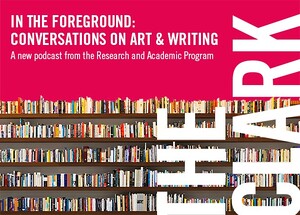225 South St
Williamstown, MA 01267
USA
Hours: Tuesday–Sunday 10am–5pm
T +1 413 458 2303
In-depth conversations with leading art historians, scholars, and artists
Williamstown, Massachusetts—The Clark Art Institute’s Research and Academic Program premieres a new podcast series, In the Foreground: Conversations on Art & Writing. Each episode offers a lively, in-depth look into the life and mind of a scholar or artist working with art historical or visual material. In the Foreground is available on iTunes, Spotify, and anywhere else you may listen to podcasts.
Episode 1: The Nature of All Our Forms: María Magdalena Campos-Pons on Performance Art
Renowned artist and Cornelius Vanderbilt Endowed Chair of Fine Arts at Vanderbilt University María Magdalena Campos-Pons recounts the exchange of ideas she has had with her mentors and other women artists and how she carries that generosity forward in her own teaching.
Episode 2: Surfaces of Projection: Dell M. Hamilton on Performance Art and Black Embodiment
Dell M. Hamilton, interdisciplinary artist, scholar, writer, and independent curator, discusses how her long affiliation with Harvard University’s Hutchins Center for African & African American Research shaped her artistic perspective.
Episode 3: An Archive of Exchange: C. Ondine Chavoya on Chicanx and Latinx Art History
C. Ondine Chavoya, professor of art history and Latino/a studies at Williams College, discusses what shaped his interest in Chicanx art, his role in establishing a Department of Latina/Latino Studies at Williams, and his work as a curator.
Episode 4: To Speak Across Time: Gabriele Finaldi on Museums
Art historian Gabriele Finaldi, who has served as director of the National Gallery in London since 2015, discusses his graduate studies at the Courtauld, and the creative power of drawing as a medium,.
Episode 5: An Embodiment of Experience: Steven Nelson on African Art and Writing History
Steven Nelson, dean of the Center for Advanced Study in the Visual Arts (CASVA) shares how his broad interests in design, travel, and histories of the African diaspora are reflected in his path toward a career in art history.
Episode 6: A Set of Ways of Engaging: Lisa Lee on Thomas Hirschhorn and Materiality
Lisa Lee, associate professor of art history at Emory University, discusses a project tentatively titled “Thomas Hirschhorn’s Real Abstraction, 1984–94,” which focuses on a critical period in the life of the artist, and art that grapples with the political, economic, and social conditions of contemporary life.
Episode 7: An Enactment of ‘The Impersonal’: Brigid Doherty on Re-thinking Subjectivity in Art
Brigid Doherty, associate professor in the departments of Art and Archaeology and German at Princeton University, discusses on the interdisciplinary study of twentieth-century art and literature, especially relationships among artistic practices and aesthetic and psychoanalytic theories.
Episode 8: Looking as Knowing: Svetlana Alpers on Critical Thinking and Photography
Svetlana Alpers, professor emerita at the University of California, Berkeley, discusses her intellectual formation and its traces in her forthcoming book on Walker Evans.
Episode 9: An Art History Yet to Come: Kirsten Scheid on Palestinian Art
Associate professor of anthropology at the American University in Beirut Kirsten Scheid discusses her research on an ethnography of aesthetic encounters in contemporary Palestine.
Episode 10: Can You Show Thinking?: Mieke Bal on Film & Writing
The cultural theorist, critic, and video artist Mieke Bal reflects on what drew her to filmmaking, delving into several of her video projects.
Episode 11: Philosophical Grounding: Michael Ann Holly on Creating Visual Studies
Michael Ann Holly, Starr Director Emerita of the Research and Academic Program (RAP) at the Clark Art Institute, discusses what drew her to art history and her contributions in founding RAP
For more information, visitclarkart.edu.
About The Clark
The Clark Art Institute, located in the Berkshires of western Massachusetts, is one of a small number of institutions globally that is both an art museum and a center for research, critical discussion, and higher education in the visual arts.


